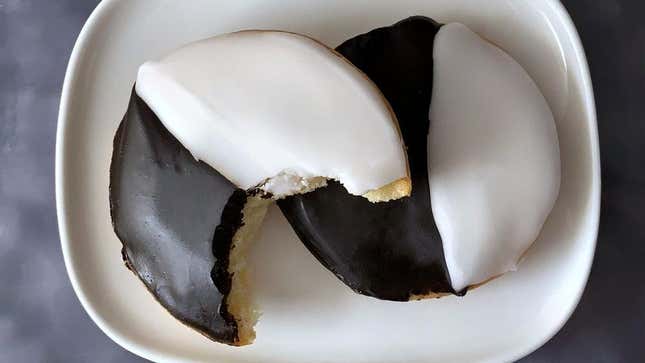
The Christmas season has me thinking about cookies, and not just typical holiday cookies. I’m thinking about all the cookies, and that includes black and whites. They’re available in other places by other names and with some variation (more on that later), but black and white cookies in their most traditional sense are a staple of metropolitan New York, meaning New York City and its surrounding area. Though these cookies are certainly not a secret, they are somewhat strictly defined.
What is a black and white cookie?
If you’re talking to a New Yorker and say you have a black and white to offer them, here’s what they’re going to expect: a vanilla cake bottom topped with royal icing or fondant, half chocolate, half vanilla. This is what you can expect to find if you’re sauntering through the holiday fair at Grand Central Terminal or popping into a bakery in Manhattan.
The base of the cookie is always vanilla. Or almost always. I recently bought a pack of what I proudly referred to as “authentic black and whites” and presented them to my brother, a former Brooklynite; he took a bite, noticed the bottom was chocolate, and scathingly ribbed me. “You said these were authentic?”
In truth, I never had a chocolate-bottomed black and white before that day, but according to Thrillist, some bakeries upstate do use chocolate as the base. It tasted good, anyway
As Vice explains, some Italian bakeries put a thin layer of apricot jam before the icing is added. “Italian bakeries make them and every bakery makes it different,” Rocco Generoso Jr. of Rocco’s Pasticceria in Manhattan told Vice.
Black and white cookies vs. half moons
In my humble opinion, the frosting-topped black and white is more delicious than the icing-topped one. I no longer live in New York City, so I feel comfortable shouting that from the rooftops.
In central New York and other parts of New England, a cookie that is very similar to the black and white, called the half-moon, is popular. Like the black and white, it has a vanilla cake bottom and its topping is split, half chocolate and half vanilla. Unlike the black and white, that chocolate/vanilla split is made up of thick layers of buttercream frosting. Notably, the bakery that folklore claims is the earliest purveyor of half moons, Hemstrought’s Bakery in Utica, offers a chocolate or a vanilla bottom, and custom versions of half moons.
Boston calls them half moons and uses frosting, too, and at least one bakery, Lyndell’s, makes them with a thicker bottom than you might find elsewhere.
“The half moon cookies at Lyndell’s Bakery are cakey mounds with a generous sugar coating, resembling their New York cousins, the black and white cookie,” wrote Kyle Grace Mills in Boston Magazine. “However, where the New York variety uses royal icing, Lyndell’s treats its cookies like cupcake tops and ices them with real chocolate and vanilla buttercream frosting.”
Other versions of the black and white cookie
There is allegedly a version of the black and white that is popular in the Midwest—the harlequin—but it’s surprisingly hard to find any information about this online. The cookie has even made its way to Germany, where it’s called the Amerikaner. There are two theories as to why they’re named “Amerikaner” there, one more probable than the other.
“Either they were brought to Germany by the GIs after the war, or they were named Ammoniakaner for ammonium hydrogen carbonate, or ‘Hirschhornsalz,’ which was used as a leavening agent,” writes Jennifer McGavin on Spruce Eats. “This seems like a stretch to many people.”
It’s a cookie that has seemingly universal appeal, either despite or because of its simplicity. Maybe that’s because this confection gives us what we really want, even if we don’t realize it: a little handheld slab of cake.